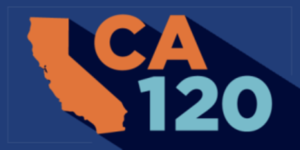News
CA120: This was an election the pollsters got right
 Directions to the local polling site in San Francisco. (Photo: Kevin McGovern, via Shutterstock)
Directions to the local polling site in San Francisco. (Photo: Kevin McGovern, via Shutterstock)Much of the coverage of the recent midterm election has been about the surprise outcome – one in which the Republicans have taken a small majority in the U.S. House of Representatives, and Democrats retained control of the U.S. Senate. However, this was the story that polling was telling us — if we were willing to listen.
The final polling numbers from non-profit and independent pollsters and news agencies, was right. NBC News polling on voter enthusiasm showed Democrats and Republicans tied at 73% saying they were highly motivated to vote on the eve of the election. That same poll showed a “generic ballot” result that had both parties at an effective tie.
The New York Times/Siena polling ended up with the most exacting predictions they have ever seen, with zero measurable bias across all their polls. And here in California, the public polling from the Institute of Governmental Studies (IGS) and Public Policy Institute of California (PPIC) nailed all the ballot measure results and every statewide contest – including early predictions of the losses expected for the two gambling measures, Propositions 26 and 27, prior to those campaigns stopping their spending, and providing evidence that Proposition 30 would fail after the Gov. Newsom came out in opposition.
The Los Angeles mayoral contest outcome was predicted in the IGS/Los Angeles Times poll both in the primary and the general election, despite many observers believing that the polling was going to be misshapen because of the more than $100 million spent by Rick Caruso and massive field program that could have turned out more unlikely voters that would be missed by traditional polling of likely voters.
While polling had it well nailed down, many were confused with how these polls were in conflict with the so-called “election fundamentals.” In political science these fundamentals are the well-worn paths that emerge in elections of a certain type, or in a certain environment.
Gubernatorial elections, for example, are low turnout with a more conservative, older electorate. Mid-term elections are a referendum on the party in power. Partisanship is more important than candidate quality.
You can think of election fundamentals as factual and research-based generalizations, but generalizations, nonetheless. A weather fundamental would be that it is hot in the summer, and cold in the winter. And this will largely hold true, except on days that it doesn’t.
Across the state and the nation, talking heads and political prognosticators who relied too heavily on election fundamentals, and discounted the polling, got it wrong. They were like a weatherman saying “it’s going to be sunny in San Diego” while discounting evidence of a cold front that is creeping in.
For an example of this, we can look at the highly rated 538 Senate and House forecasts. In the Senate, the “Deluxe” model, which includes polling, election fundamentals and expert ratings, Republicans were at a 59% chance of controlling the Senate, and Democrats at just 41%. Republicans had a roughly 20-point advantage, which was obviously not what happened.
The “Lite” model, which was just the polling, was dead on at 50% probability for each party’s control of the Senate – basically what happened with Democrats holding the Senate and a runoff in Georgia set for the 51st seat.
The lite U.S. House forecast was also better for Democrats at a 25% chance of holding the majority compared to just 16% in the deluxe model. Both will likely turn out to be right, in the binary question of who gets to hold the gavel of House leader, but the polling-only lite version of the model was significantly better and more reflective of where the country was.
One advantage of polling is that results are “weighted.” This process allows pollsters to take a polling sample of 400 people in a district with 500,000 residents, and make it comprise the right share of each partisan group, representative across age groups, ethnicity, regional variations and even education/income levels. Pollsters take the data given to them, which is usually somewhat imperfect, and they have to massage it to uplift the underrepresented, and suppress a bit the voices in the survey that were over-sampled.
Something election forecasters can learn for future elections is to “weight” the election fundamentals.
Unpacking these election fundamentals, we can ask ourselves, why is the election a referendum on the party in power? The fact is that the party in power is in the news, making policy, and having the greatest impact on the lives of voters.
This could have been weighted down a bit given how for the first time in modern history it was the former president who was in the news in the months leading up to the election. Checking Google trends over the summer you could see more people searching Trump than Biden, likely due to the documents taken by the DOJ from Mar-a-Lago, the New York lawsuit over his business practices, and the Jan. 6 hearings.
Another reason for the midterm dip for the party in power is that after just two years, supporters are disappointed that they have not achieved everything they set out to do. And partisans on the other side are angry and motivated to fight back against what they have achieved.
This could be seen in Biden’s low favorability ratings that can come from both the partisan opponents, and softening or disappearing support from his political base.
In this election few voters were focused on Biden’s policies.
The biggest policy to hit voters in the lead up to the general election was the U.S. Supreme Court decision in Dobbs v. Jackson to eliminate abortion rights at the national level – a policy change that was precipitated by the last administration and the Republican Senate who built a very conservative-leaning supreme court. And Biden’s low favorables – those were washed away in many cases by the even lower favorables for Trump allies and election deniers.
The expected Republican turnout advantage in gubernatorial elections also needed to be questioned.
Five states had abortion measures on the ballot, while another half-dozen had highly targeted U.S. Senate seats. In these states we saw markedly increased participation, including higher registration and turnout from younger voters. And in California the abortion measure Proposition 1 gave Democrats a platform to run on and turnout voters that was much more effective than pushing statewide candidates in races that seemed like forgone conclusions.
All this isn’t to say that we ignore election fundamentals. But we need to put them into perspective, and when other data is pointing in another direction we can determine if there are reasons that preconceived notions about an election cycle should be tamped down.
Even if it is a hot summer, the next time there’s a frost outside, maybe we accept that data and recalibrate our weather expectations.
—
Editor’s Note: Paul Mitchell, a regular contributor to Capitol Weekly, is the creator of the CA120 column, vice president of Political Data and owner of Redistricting Partners, a political strategy firm.
Want to see more stories like this? Sign up for The Roundup, the free daily newsletter about California politics from the editors of Capitol Weekly. Stay up to date on the news you need to know.
Sign up below, then look for a confirmation email in your inbox.

Leave a Reply